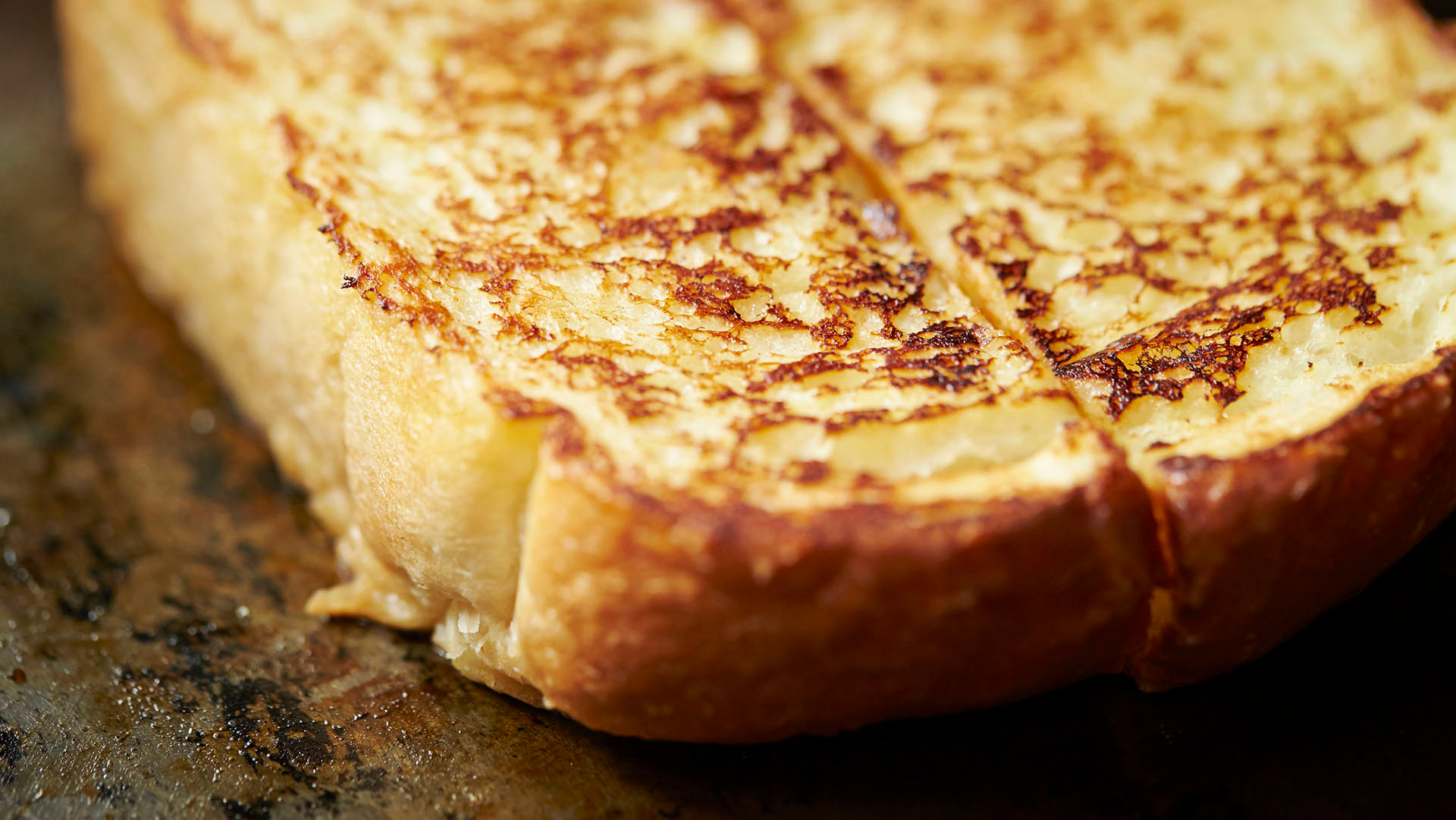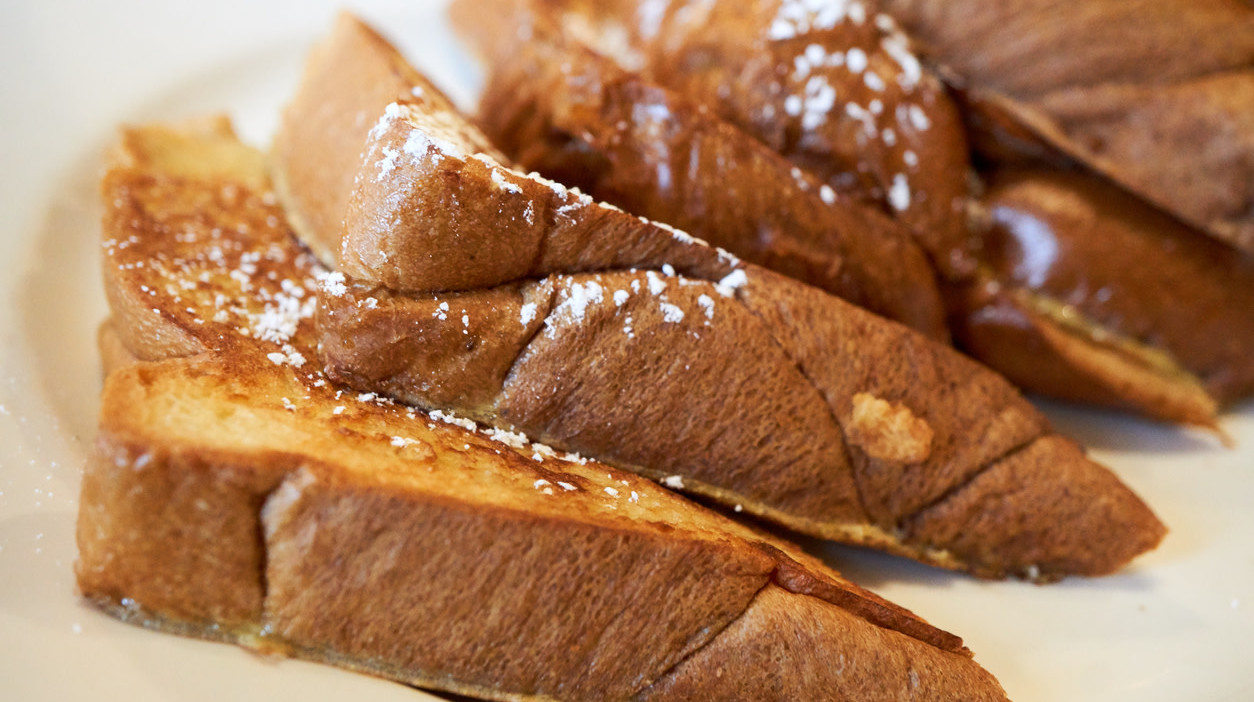The Very Best French Toast Doesn't Even Need Syrup
Italian bread, eggs, milk, butter, and syrup—those were always the five ingredients my railroad-worker father used to make French toast for us. He ate it plain, but my brother and I wanted ours topped with an unholy amount of sugar. I remember my Mom trying to teach me about portion control, in the hopes that I wouldn't create a giant pond of sweet syrup on my plate.
That memory is decidedly American, and French toast, aka pain perdu, is, after all, French. The French don't eat French toast with butter and syrup and a half cup of sugar, and moreover, some brunch spots don't serve it that way anymore either. In my quest to improve my own French toast skills, I wanted to speak to somebody knowledgeable about both brunch service and France, so I spoke with Sarah Bessade, the French-born owner of Loupiotte Kitchen, a popular café in L.A.'s Los Feliz neighborhood.
Bessade was previously the owner of Paris' Gabylou, a restaurant that became a sensation from day one. She sold Gabylou, moved to L.A. to open Loupiotte, and suddenly she's here smoking a cigarette talking to me about French toast. What makes a good one? What must French toast have? What are the basics? The huge mistakes? What does she think about syrup? Talking about French toast with Bessade is like getting drunk and talking about politics; the deeper we get the more the conversation has the cadence of radicalism, so try to imagine her quotes with as much vigor as possible.
The Bread
The single most important part of French toast is the bread. "Look, you can put butter on shitty bread, but it's still shitty bread," Bessade says. Historically, French toast was made from old baguettes, but Bessade tells me she can't find a good baguette in L.A., so she uses brioche. Brioche is elegant and buttery, delicious all on its own. Bessade, like my Dad, prefers her pain perdu plain, maybe with a little bit of powdered sugar, but she insists that if the bread is of good quality you won't need much else. This goes against my own thinking, which is to double or even triple down on fats and flavors when I cook. I rarely sit down to eat breakfast anymore, and if I do, I'm making a spectacle of it.
Tip: The older the bread the better, as it becomes more inclined to soak up the moisture from the batter and achieve a crusty exterior. French toast should be a little crusty on the outside, and moist on the inside. Cut thick, too: Slices should be the size of your thumb, like Texas toast. Nothing worse than a flimsy, brittle piece of white bread that would rip in half if you made fun of it.
The Batter
I'm a fan of large eggs, cream, and vanilla extract. Cinnamon is definitely in the conversation. Nutmeg might be preferred. I don't think I've ever once measured out how much milk or cream I've used in French toast batter, but I bet something like a 2:1 egg-to-cream ratio is about what we're all doing. Bottom line: There needs to be a lot of batter, because old bread will absorb it in large quantities. Some recipes call to let it soak for as long as 4 minutes on each side, whereas Gordon Ramsay will tell you to batter the bread quickly. I like to let it marinate. Let it soak up the batter as much as possible. If the bread is old, it can take it, and the texture only improves in the end.
Tip: Undershooting the quantity of batter required is a rookie mistake. We've all tried to soak up the last little bit of French toast batter with a new piece of bread. Then you cook it, and it's like eating plain toast. I know you know what I'm talking about.
Butter and Syrup
Well, here's where things get divisive. Bessade thinks butter and syrup is gauche, telling me: "You know how I feel when somebody asks me for syrup? It's the same feeling when somebody asks for ketchup with their eggs." She goes on further, "You wouldn't put sauce on a good steak, would you? No." (I then explained to her what A1 sauce was, and she looked mortified.) She's got a good point, though: If you're using good bread and ample batter, you don't need gobs of syrup and butter. Still, some good honey or quality maple syrup is hard to beat, and I don't think there's anything wrong with that.
Tip: Don't let the French bully you.
Alternative Fixin’s
That said, there is a pretty good alternative to butter and syrup, and that is fruit and cream. Loupiotte uses chantilly, homemade whipped cream with a faint vanilla flavor. Personally, I think French toast reaches its peak with any homemade cream. I made some fresh ricotta recently and it worked perfectly. Ricotta done fresh is a little sweet and dessert-like in flavor, not like the store-bought stuff. I bet crème fraîche would work, too, and that's even easier to make than ricotta. Spend a little extra time on the cream portion if you're trying to impress somebody. As far as fruit, Bessade uses whatever is in season; last week she had raspberries and blueberries.
Tip: Loupiotte serves pain perdu with a little grated orange zest on top. That zest at the end goes a long way, and adds a freshness to the dish that wouldn't have been there otherwise.
Many chefs don't care for American breakfast. David Chang famously expressed his disdain for it on Ugly Delicious, and Bessade obviously has some issues with Americans' penchant for syrup. I get it. An American breakfast does typically deal heavily in sugar and meat quite early in the morning, but I love it, and syrup and butter are a huge part of the appeal.
Sometimes, I want fat stacks of pancakes and massive links of sausage. Give me bagels with cream cheese and artificial cereal that shaves years off my life. That said, the French toast at Loupiotte is all the more astonishing because it's light on sugar, yet still decadent. It's a more sustainable type of breakfast, and it doesn't compromise on flavor or satisfaction. It's French toast, grown up. Don't think of it as a pretension, just an alternate way to eat a classic.

